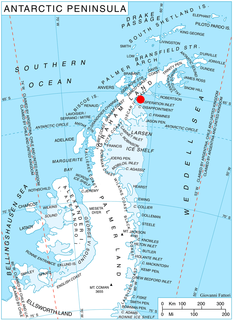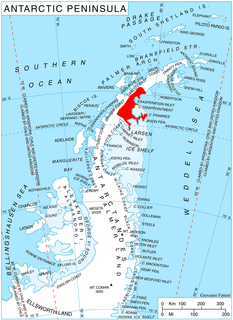Related Research Articles

Thurston Island is an ice-covered, glacially dissected island, 215 km (134 mi) long, 90 km (56 mi) wide and 15,700 km2 (6,062 sq mi) in area, lying a short way off the northwest end of Ellsworth Land, Antarctica. It is the third largest island of Antarctica, after Alexander Island and Berkner Island.
Mill Inlet is an ice-filled inlet which recedes 8 nautical miles (15 km) in a northwesterly direction and is some 20 nautical miles (37 km) wide at its entrance between Cape Robinson and Monnier Point, along the east coast of Graham Land, Antarctica. It was charted by the Falkland Islands Dependencies Survey in 1947 and named for Hugh Robert Mill. It was photographed from the air during 1947 by the Ronne Antarctic Research Expedition under Finn Ronne.

Cape Disappointment is a cape which marks the tip of the ice-covered Akra Peninsula lying between Exasperation Inlet and Scar Inlet, on the east coast of Graham Land. It was discovered in 1902 by the Swedish Antarctic Expedition, under Otto Nordenskiöld, and so named by him because he encountered many difficult crevasses in approaching the cape.

Foyn Point is a point surmounted by a peak 525 metres (1,720 ft) high, forming the southeast extremity of Blagoevgrad Peninsula and marking the north side of the entrance to Exasperation Inlet, on Oscar II Coast on the east side of Graham Land, Antarctica. Sir Hubert Wilkins on a flight of December 20, 1928 photographed what appeared to be an island off the east coast, later charting it in 66°30′S62°30′W. Subsequent comparison of Wilkins' photographs of this feature with those taken by the Falkland Islands Dependencies Survey, who charted the coast in 1947, indicate that this point, although considerably north of the position reported by Wilkins, is the feature named by him as "Foyn Island". The name Foyn Point is given to the southeast extremity of this feature. It is named for Svend Foyn.

Adie Inlet is an ice-filled inlet, 25 miles (40 km) long in a northwest–southeast direction, lying east of Churchill Peninsula along the east coast of Graham Land. Charted by the Falkland Islands Dependencies Survey (FIDS) and photographed from the air by the Ronne Antarctic Research Expedition (RARE) during 1947. Named by the FIDS for R.J. Adie, South African geologist with FIDS, 1947–49.

Crane Glacier, is a narrow glacier which flows 30 miles (50 km) in an east-northeasterly direction along the northwest side of Aristotle Mountains to enter Spillane Fjord south of Devetaki Peak, on the east coast of the Antarctic Peninsula. Sir Hubert Wilkins photographed this feature from the air in 1928 and gave it the name "Crane Channel", after C.K. Crane of Los Angeles, reporting that it appeared to be a channel cutting in an east-west direction across the peninsula. The name was altered to "Crane Inlet" following explorations along the west coast of the peninsula in 1936 by the British Graham Land Expedition, which proved that no through channel from the east coast existed as indicated by Wilkins. Comparison of Wilkins' photograph of this feature with those taken in 1947 by the Falklands Islands Dependencies Survey shows that Wilkins' "Crane Channel" is this glacier, although it lies about 75 miles (120 km) northeast of the position originally reported by Wilkins.

Flask Glacier, is a gently-sloping glacier, 25 nautical miles long, flowing east from Bruce Plateau to enter Scar Inlet between Daggoo Peak and Spouter Peak in Graham Land, Antarctica. The lower reaches of this glacier were surveyed and photographed by the Falklands Islands Dependencies Survey (FIDS) in 1947. The entire glacier was photographed by the Falkland Islands and Dependencies Aerial Survey Expedition in 1955–56, and mapped by the FIDS in 1957. It was named by the UK Antarctic Place-names Committee after the third mate on the Pequod in Herman Melville's Moby-Dick; or, The White Whale.
Berg Ice Stream is an ice stream about 30 nautical miles (60 km) long flowing into Carroll Inlet between Rydberg Peninsula and Espenschied Nunatak, on the English Coast. It was mapped by the United States Geological Survey from surveys and from U.S. Navy air photos, 1961–66, and named by the Advisory Committee on Antarctic Names after Captain Harold Berg, commander of USNS Eltanin on Antarctic cruises, 1964–65.

Jorum Glacier is a glacier draining the southeast slopes of Forbidden Plateau, and lowing east into Exasperation Inlet, just north of Caution Point, on the east coast of Graham Land, Antarctica. It was surveyed by the Falkland Islands Dependencies Survey in 1947 and 1955. The UK Antarctic Place-Names Committee name alludes to the punchbowl shape of the head of the glacier, a "jorum" being a large drinking bowl used for punch.
Johnston Glacier is a glacier flowing in a southeasterly direction along the north side of Mount Owen to the head of Nantucket Inlet, on the east coast of Palmer Land, Antarctica. It was discovered by the Ronne Antarctic Research Expedition, 1947–48, under Finn Ronne, who named it for Freeborn Johnston of the Department of Terrestrial Magnetism at the Carnegie Institute, Washington, D.C., in recognition of his contributions to the planning of the geophysical program and the working up of the results for the expedition.

Krak Glacier is an outlet glacier of Kraków Dome at the head of Lussich Cove, Martel Inlet, Admiralty Bay, King George Island, in the South Shetland Islands.It was named by the Polish Antarctic Expedition, 1980, after the legendary prince Krak, founder of Kraków and killer of the Wawel Dragon.
Gurling Glacier is a glacier draining between Krebs Ridge and Leininger Peak into the southwest corner of Smith Inlet, on the east coast of Palmer Land, Antarctica. It was named by the UK Antarctic Place-Names Committee after Paul William Gurling, a British Antarctic Survey surveyor who worked in the general vicinity of this feature. Paul was a BAS surveyor, Stonington Island.
Trail Inlet is an ice-filled inlet which recedes southwest 15 nautical miles (28 km) between Three Slice Nunatak and Cape Freeman, on the east coast of Graham Land. The inlet was sighted by Sir Hubert Wilkins on his flight of December 20, 1928. The width of Graham Land is reduced to 20 nautical miles (37 km) between the heads of Trail Inlet and Neny Fjord. So named by the US-SCAN because it was a natural route of travel for flights and sledge trips from the East Base of the United States Antarctic Service (USAS), 1939–1941, to the east coast of Graham Land.

Punchbowl Glacier is a glacier that flows southwards between Poibrene Heights and Metlichina Ridge, and enters the north end of Exasperation Inlet, north of Jorum Glacier, on the east side of Graham Land, Antarctica. Surveyed by Falkland Islands Dependencies Survey (FIDS) in 1947 and 1955. The name applied by United Kingdom Antarctic Place-Names Committee (UK-APC) is descriptive of shape as the glacier is hemmed in by mountains.

Pequod Glacier is a glacier over 15 nautical miles (28 km) long, draining eastwards between Parlichev Ridge to the north, and Taridin Ridge and Krupen Ridge to the south, and flowing into Exasperation Inlet on the east coast of Graham Land. It lies parallel and just south of Melville Glacier. The lower part of the glacier was surveyed by Falkland Islands Dependencies Survey (FIDS) in 1947 and the upper reaches were surveyed in 1955. Named by United Kingdom Antarctic Place-Names Committee (UK-APC) after the whaling ship Pequod in Herman Melville's Moby-Dick.

Evans Glacier is a gently-sloping glacier 15 nautical miles (28 km) long and 4 nautical miles (7 km) wide, draining the southeast slopes of Travnik Buttress eastwards between Rugate Ridge and Poibrene Heights to flow into Vaughan Inlet on the east coast of Graham Land, Antarctica. It was discovered by Sir Hubert Wilkins in an aerial flight, December 20, 1928, and named "Evans Inlet" by him for E.S. Evans of Detroit. A further survey by the Falkland Islands Dependencies Survey in 1955 reported that this low-lying area is not an inlet, but is formed by the lower reaches of Hektoria Glacier and the feature now described.
Flint Glacier is a glacier which flows south into Whirlwind Inlet between Demorest Glacier and Cape Northrop, on the east coast of Graham Land, Antarctica. It was discovered by Sir Hubert Wilkins on his flight of December 20, 1928, and photographed from the air by the United States Antarctic Service in 1940. It was charted in 1947 by the Falkland Islands Dependencies Survey, who named it for glaciologist Richard F. Flint, professor of geology at Yale University.
Handel Ice Piedmont is a large ice piedmont lying north and west of the Colbert Mountains, between Haydn Inlet and Schubert Inlet on the west-central coast of Alexander Island, Antarctica. Apparently first seen from the air by the United States Antarctic Service in 1940 but not separately mapped, it was first mapped from air photos taken by the Ronne Antarctic Research Expedition, 1947–48, by Searle of the Falkland Islands Dependencies Survey in 1960. The feature was named by the UK Antarctic Place-Names Committee for George Frideric Handel, the German composer.

Starbuck Glacier is a glacier 15 nautical miles (28 km) long, flowing east along the south side of Taridin Ridge and Padesh Ridge, and entering Scar Inlet immediately north of Mount Queequeg, on the east coast of Graham Land. Surveyed and partially photographed by the Falkland Islands Dependencies Survey (FIDS) in 1947. The entire glacier was photographed by the Falkland Islands and Dependencies Aerial Survey Expedition (FIDASE) in 1955–56, and mapped from these photos by the FIDS in 1957. Named by the United Kingdom Antarctic Place-Names Committee (UK-APC) after the first mate on the Pequod in Herman Melville's Moby-Dick.

Rachel Glacier is a glacier on the east coast of Graham Land, 6 nautical miles (11 km) long, flowing east between Krupen Ridge and Padesh Ridge to enter Exasperation Inlet southwest of Mihaylovski Crag. The name, applied by United Kingdom Antarctic Place-Names Committee (UK-APC), is taken from Herman Melville's Moby Dick, the Rachel being a ship from Nantucket which met the Pequod and brought news of a lost whaleboat.
References
- ↑ "Exasperation Inlet". Geographic Names Information System . United States Geological Survey . Retrieved 2012-03-09.